CRM systems are essential tools for businesses of all sizes. Ensuring that you have clean CRM data to work with is necessary for making the most of the data that you collect—and maximizing your growth.
Unfortunately, many companies are still living in the past, passing Excel files back and forth, and performing annoying and tedious data maintenance tasks to ensure that their data stays clean. Often, data quality improvement initiatives are a company-wide effort with individuals from any department that uses customer data playing at least a small role.
However, managing and updating CRM data using Excel CSVs can be problematic for many reasons. Here are 10 reasons not to use Excel to manage and update your CRM data.
1. Excel Requires a Specific Skill Set
While Excel has a deep feature set that can help solve almost any data-related problem, it does require specific skills.
You should be comfortable with basic Excel functions like sorting, filtering, and formatting data. More advanced skills like using VLOOKUP, HLOOKUP, INDEX-MATCH, pivot tables, and creating macros can be very beneficial.
For that reason, among the others listed in this article, Excel is not an ideal solution for data maintenance tasks.
2. Customer Data Maintenance in Excel Is Time-Consuming
Managing and updating CRM data in Excel can be a lengthy process. Tasks such as data entry, data cleaning, report generation, and troubleshooting errors need to be done manually, which can take up a significant amount of time.
For example, if you're importing new CRM data into Excel, you might need to spend time cleaning the data, removing duplicates, and checking for errors. All of these tasks require custom solutions in Excel. And, because each CSV will only contain a fraction of your records, you’ll have to repeat the tasks across many CSVs to clean your entire database.
Similarly, if you're generating a report, you might need to manually create formulas, format the data, and design the report layout.
These tasks can take up a significant amount of your team's time, which could be better spent on more strategic tasks.
3. Collaboration and Versioning Challenges
Excel, while a powerful tool for individual tasks, falls short when it comes to collaborative work, especially in the context of CRM data management. The process of sharing Excel files via email, keeping track of different versions, and segmenting data for different tasks or teams can be complex and inefficient.
When team members need to update the CRM data, they have to locate the most recent Excel file, load it, make their changes, save the file, and then send it back to the rest of the team. This process is not only time-consuming but also increases the risk of errors or miscommunications. For instance, if two team members are working on the file simultaneously, they might make conflicting changes, leading to confusion and potential data loss.
Moreover, Excel lacks robust version control features, making it difficult to track changes, who made them, and when. This is compounded by the file-sharing issues, because project managers may try to assess changes in a file that is outdated.
This can lead to inconsistencies and inaccuracies in the CRM data when older versions of datasets are accidentally imported into the system.
Segmenting your database for different tasks or teams can also be a challenging process in Excel. Team members often have to manually sort and filter the data to find the information they need. This takes time and is susceptible to errors.
|
Related articles How to Become a Customer Data Wizard Using the ‘Transform Data’ Tool CRM Data Quality Checklist: Top 15 Issues The Complete Guide to Bulk Updating CRM Data Without Using Excel |
4. Limited Scalability and Crashes With Large Data Sets
Excel, despite its wide range of uses, has inherent limitations when it comes to scalability, particularly when dealing with large data sets.
As the volume of data increases, Excel can start to slow down, affecting its performance and efficiency. This can lead to longer load times, slower calculations, and even crashes, which can disrupt your workflow and lead to data loss. Furthermore, if your data exceeds Excel's maximum capacity, you'll have to split it across multiple files, making it more difficult to manage and analyze your data holistically.
The latest version of Excel can handle a maximum of 1,048,576 rows and 16,384 columns. While this might seem substantial, it can quickly become a constraint as your organization grows and accumulates more CRM data. Additionally, “maximum” is the operative word here. Excel advertises that the software can technically handle that much data, but that doesn’t mean that you won’t see crashes from much smaller data sets. The software is also constrained by the limitations of the computer running it, and what other tasks the computer is performing at the same time.
5. Need To Create Documentation for All Solutions
When using Excel for CRM data management, it's often necessary to create detailed documentation for all solutions. This documentation needs to explain how to use and update the Excel files correctly, including how to input data, how to use formulas and functions, how to generate reports, and more.
This documentation can also be tedious to assemble because different formulas must be created for every potential data problem, across every field in your database. Even similar solutions, such as formatting first names and company names for the proper capitalization, will have differences between them. For example, first names might include salutations like “Mr.” that need to be accounted for, while company names will include common terms like “LLC,” “Co,” or “Corp.”
This documentation also needs to be updated regularly to reflect any changes in the data or procedures, which adds to the workload. Furthermore, if the documentation is not clear, comprehensive, or up to date, it can lead to confusion among team members, resulting in mistakes and inefficiencies.
Additionally, relying on documentation can slow down the workflow, as team members may need to constantly refer back to the documentation to ensure they're performing tasks correctly. This can interrupt their work and reduce their productivity.
6. Need To Enforce Updating and Import Standards
When managing CRM data in Excel, it's crucial to enforce standards for updating and importing data. This is important to maintain data integrity and consistency across your CRM system. However, enforcing these standards in Excel can be challenging.
First, Excel does not provide built-in features to enforce data entry standards. Users can enter data in any format they choose, which can lead to inconsistencies. For instance, one user might enter dates in the format "MM/DD/YYYY," while another user might use "DD-MM-YYYY." These inconsistencies can cause confusion and make it difficult to segment, filter, and analyze the data.
Second, when importing data into Excel, there's often a disconnect between where the work takes place (Excel) and where the enforcement happens (probably in some document). This means that users need to manually check that the imported data meets the required standards, which takes time and is prone to errors.
7. No Validation Options for Many Fields
Excel does not offer validation options for many fields, which can lead to data integrity issues. For instance, users can input any type of data into any cell, regardless of what type of data should be in that cell. This lack of validation can result in inaccurate or inconsistent data.
For example, a user might accidentally enter a customer's phone number into a field that's meant for their email address. Without validation, Excel would not flag this as an error, and the mistake might go unnoticed.
8. A Lack of Reliable Automation Capabilities
Excel does not offer robust automation features. This means that many tasks, such as data entry, data cleaning, and report generation, need to be done manually. As with all the other issues with using Excel for data management, these manual processes require significant man-hours and increase the likelihood of unintentional errors.
For instance, if you're updating your CRM data, you might need to manually copy and paste data from one sheet to another, check and correct any errors, and then generate reports based on the updated data. This process can take a significant amount of time, especially if you're dealing with large data sets.
Furthermore, the lack of automation can lead to inconsistencies in your data. If different team members are performing the same tasks manually, they might do them in slightly different ways, with different results.
While some automation can be applied to a single spreadsheet to enforce standards and apply functions to rows, columns, or cells, there is no way to consistently apply that automation across other files that may be used for the same tasks with other data segments.
9. Data Security Concerns
Excel lacks robust security features, which can pose a significant risk when storing sensitive CRM data. Excel files can be easily shared, copied, or lost, potentially exposing sensitive customer information. While Excel does offer some basic security features, such as password protection, these are not sufficient for protecting sensitive data, and most companies do not use password protection because it slows down their processes.
For instance, if an Excel file containing CRM data is sent via email, it could be intercepted or accidentally sent to the wrong recipient. Similarly, if the file is stored on a shared network drive, unauthorized users might gain access to it. Furthermore, Excel files are vulnerable to viruses and other malicious software, which can lead to data loss or corruption.
10. Lacking Integrations With Other Tools
Excel does not easily integrate with other tools and systems. While many CRMs have app stores that do offer a variety of types of CRM-integrated Excel apps, these apps are often limited in their scope and feature set. Additionally, many do not include approval features that allow project managers to analyze changes before colleagues push them to their live CRM systems.
This can make it difficult to sync your CRM data with other business systems, leading to inefficiencies and potential data inconsistencies. For example, if you're using a separate tool for email marketing, you might need to manually export your CRM data from Excel and import it into the email marketing tool. As with all manual processes, this requires time that could be spent on other tasks, and leaves you vulnerable to errors.
Further, the lack of integration can lead to data silos, where different sets of data are stored separately and not easily accessible. This can make it difficult to gain a holistic view of your customer data and can hinder your ability to make data-informed business decisions.
How Insycle Addresses CRM Data Management Challenges
Insycle is a comprehensive data management solution that addresses many of the challenges associated with using Excel for CRM data management. It offers a range of features designed to streamline and automate data management tasks, fix nearly any data issue, improve data quality, and enhance collaboration.
Here are some of the ways Insycle can help:
- merging duplicates automatically, in bulk
- standardization and formatting of critical fields
- associations of contacts to companies
- importing, exporting, and comparing records
- decluttering and cleansing your CRM
- bulk operations such as updates, deleting, and more
- analyzing data
- streamlining data entry
Let’s take a look at each of these functions in depth.
Merging Duplicates in Bulk and Automatically
One of the common challenges in CRM data management within Excel is dealing with duplicate records that impact your bottom line. Building custom formulas to identify and merge duplicates is difficult and prone to errors. Once built, a custom formula is still likely to miss many duplicates that more advanced systems would detect.
Unlike Excel, Insycle’s Merge Duplicates module was created specifically for the purpose of merging duplicates in your CRM. Insycle offers powerful deduplication features that allow you to identify and merge duplicates in bulk and automatically, saving time but also improving the accuracy and consistency of your CRM data.
With Insycle, you can use any field in your CRM as a duplicate matching field. Insycle also offers advanced controls for how the data in that field is evaluated.
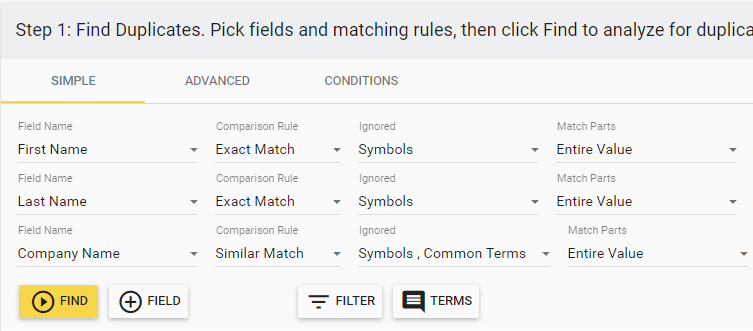
Merging duplicate contacts in Insycle
Then, you can set rules for how data is retained on a case-by-case basis for each field. This allows you to ensure that critical data ends up in the resulting post-merge master record and is never lost in the merging process.
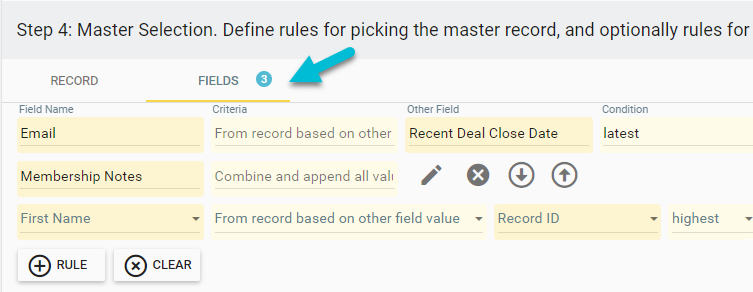
Setting rules for data retention for specific fields when merging in Insycle
Standardize and Format Critical Fields
Insycle can also help standardize and format any text field in your CRM data, including names, job titles, addresses, industries, URLs, and more. This ensures that your data is consistent and easy to analyze.
Using Insycle, you can analyze the contents of each field, identify variations, and easily standardize them for consistency.
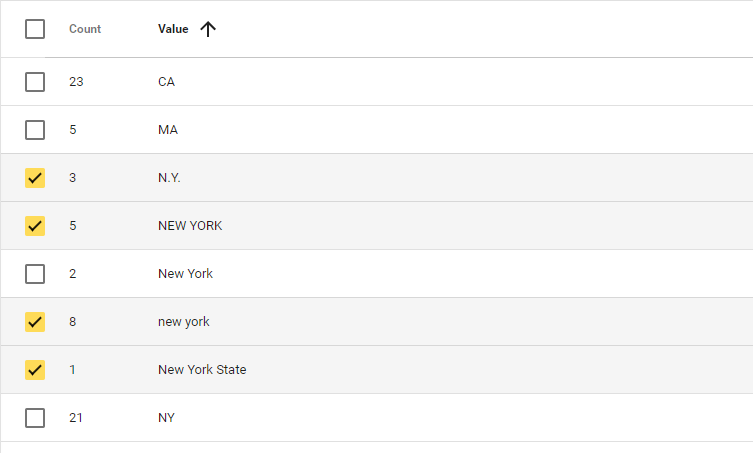
Selecting variations of similar data points for standardization in Insycle
Additionally, Insycle offers built-in functions for formatting popular fields like contact names, company names, addresses, phone numbers, states, zip codes, and more.
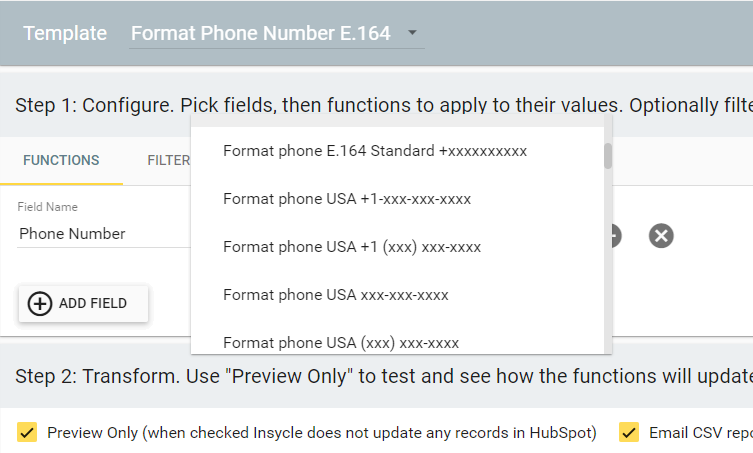
Some of the available functions for formatting phone numbers in Insycle
Associating and Linking People to Companies
Insycle can also help associate and link people, companies, and deals in bulk and automatically, a task that can be complex and time-consuming in Excel. This allows you to gain a more holistic view of your customer relationships and improve your sales and marketing efforts, especially in account-based initiatives.
Like with duplicates, you can use any CRM field as a potential matching field for connecting two records together.
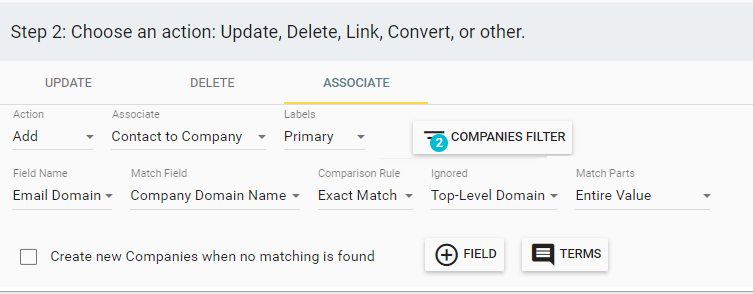
Associating contacts to companies in Insycle
Importing, Exporting, and Comparing
Insycle simplifies the process of working with CSV files. You can easily import or compare CSV data without the need for complex Excel operations.
Insycle will automatically map your columns to existing fields in your CRM database, identify existing records in your CRM, and give you control over how the imported data is used—creating new records, updating existing records, or filling empty fields.
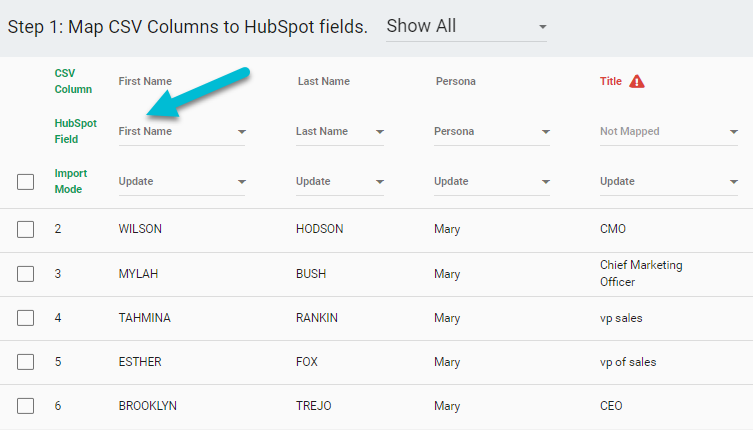
Creating field mapping templates for future CSV imports in Insycle
You can also format and clean import data on entry, ensuring that newly imported data is clean and consistent with your enforced conventions.
Saved templates let you ensure that anyone who imports data through Insycle follows your most important conventions. The result is a clean and consistent data importing process across your teams.
Decluttering and Cleansing
Insycle offers features to declutter and cleanse your CRM data. You can purge unnecessary data, migrate legacy fields, and fix inconsistent values.
Insycle’s Customer Data Health Assessment monitors numerous metrics that can help companies identify outdated and low-quality records. These metrics are organized into categories. For example, there is the invalid data category, which helps companies monitor and fix issues like invalid zip codes, free email addresses, spam email addresses, invalid phone numbers, and other issues that can be a sign that a record is of low value and relevance.
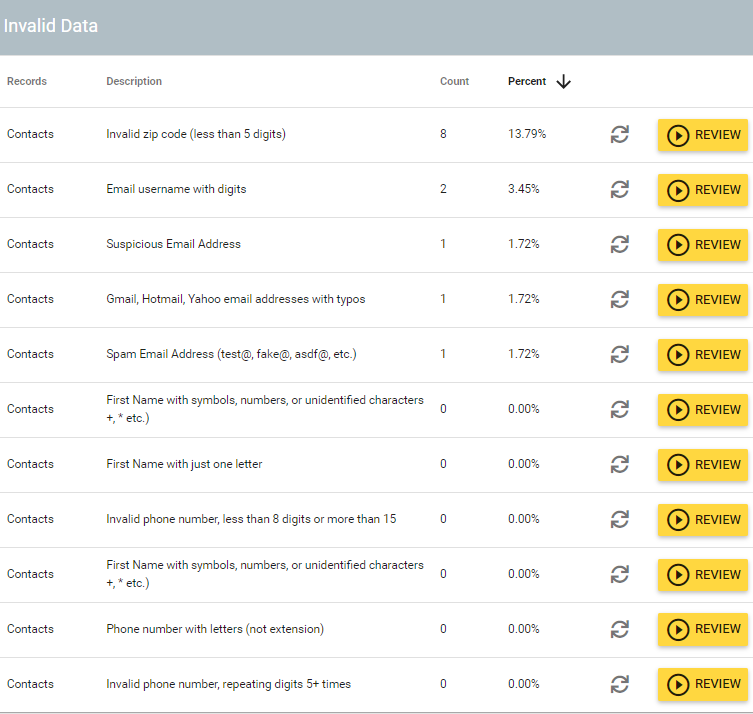
Tracking invalid data in your CRM with Insycle’s Health Assessment
By clicking the Review button in the Health Assessment, you’ll be taken to the correct Insycle template to either analyze or fix the selected issue.
Another Health Assessment category that would be relevant for dealing with outdated and low-quality records is the low-quality data category, which tracks things like contacts with do-not-reply emails, role-based emails (like admin@site.com or sales@site.com), or contacts that have been inactive for more than six months and have not opened any emails from your company during that time.
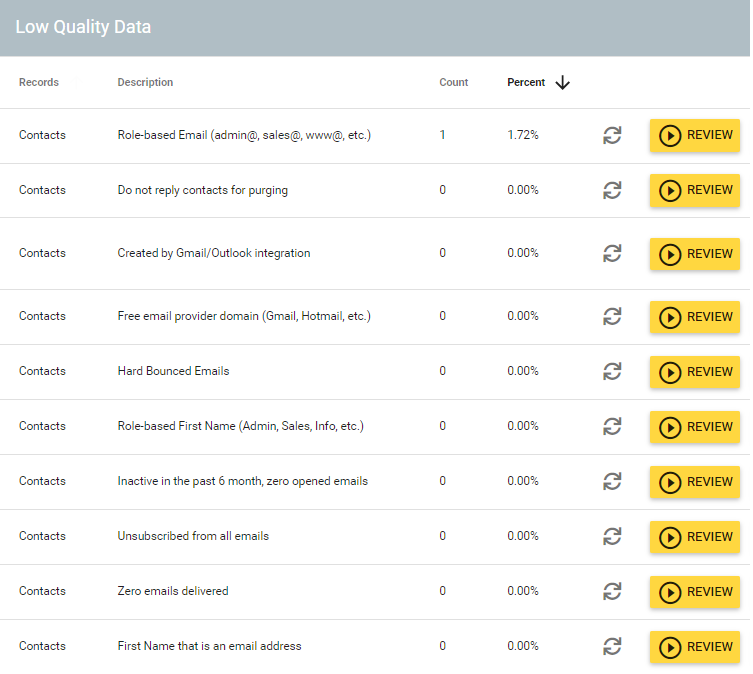
Tracking low quality data in your CRM with Insycle’s Health Assessment
Each of these separate issues has a corresponding template that you can view to look at the underlying records that meet the criteria. While low-quality data is not always outdated, it can be a good indicator that the record has not been updated for some time.
Bulk-Updating, -Deleting, -Clearing, -Assigning, and -Mapping
With Insycle, you can perform bulk operations such as updating, deleting, clearing, assigning, and mapping fields. This can save a significant amount of time compared to performing these tasks manually in Excel.
Every Insycle plan includes dozens of pre-built functions to help you tackle common data issues. Insycle also gives you the ability to build advanced custom templates to solve data issues that are unique to your organization.
For example, in the template below, Insycle is pulling first name and last names from email addresses that are formatted like “firstname.lastname@company.com,” formatting the names for proper capitalization, and injecting the first and last names into their respective CRM fields.
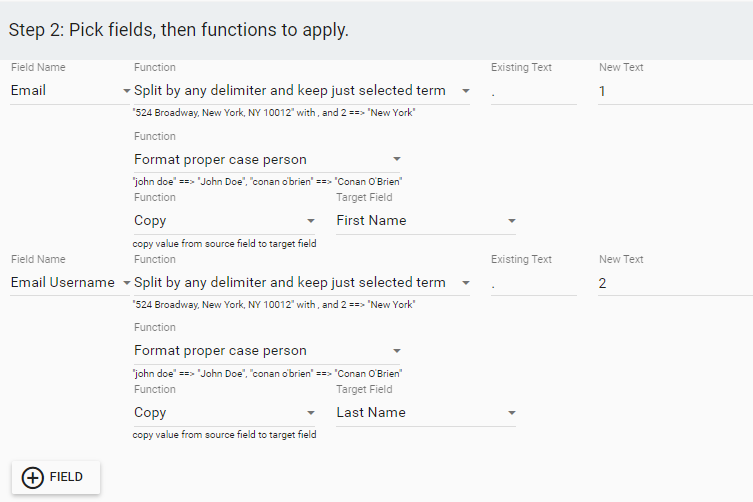
Bulk-formatting fields in Insycle
Analyzing Data
Insycle also provides powerful data analysis features. You can explore database fields, analyze values, and gain insights from your CRM data, without the need for complex Excel formulas or pivot tables.
With Inycle, you can slice and dice your CRM data in advanced ways, creating highly targeted segments for campaigns or reporting.
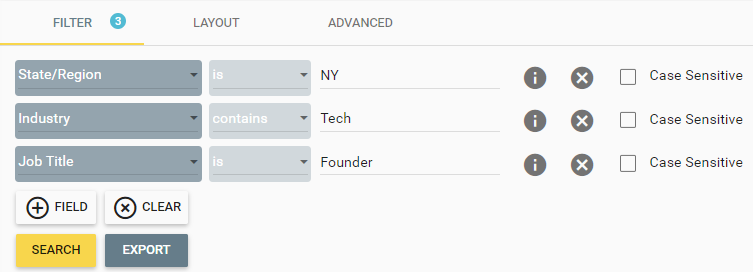
Advanced filtering in Insycle
Streamlining Data Entry
In tandem with the advanced filtering features, Insycle also streamlines manual data entry tasks. Using the Grid Edit module, you can quickly segment your data, export it, manually correct errors, fill in incomplete data, and facilitate team collaboration, making your CRM data management processes more efficient. 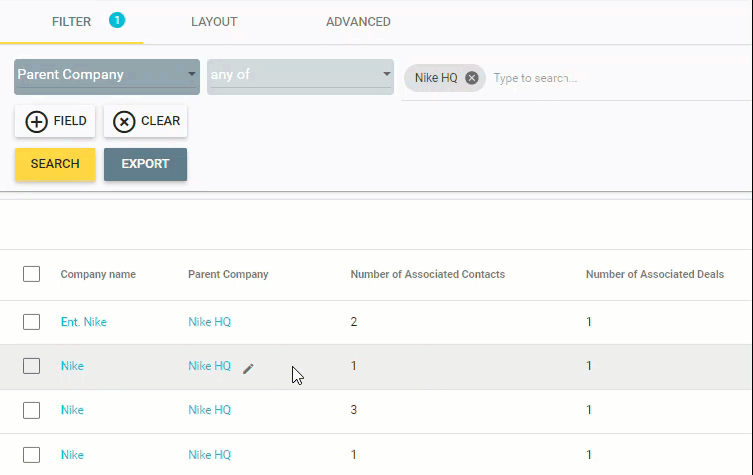
Easily updating and correcting data in Insycle
Embracing the Future of Data Management
Insycle represents a significant upgrade over traditional methods of maintaining CRM data, such as Excel. Insycle addresses the limitations of Excel by offering robust features for collaboration, version control, scalability, data validation, automation, and security. With Insycle, businesses can streamline their data management processes, reduce errors, and save time. No longer do teams need to pass Excel files back and forth and struggle with versioning issues, or manually enforce updating and import standards. Instead, they can focus on leveraging their CRM data to drive growth and success.
But Insycle is more than just an upgrade over Excel—it's a complete customer data management solution that helps companies improve data operations across the board. With features for deduplication, standardization, lead-to-account matching, data cleansing, bulk-updating, data analysis, data entry, data validation, and more, Insycle can help businesses address blind spots in their data management strategy and gain a more comprehensive understanding of their CRM data.
We invite you to learn more about Insycle and how it can revolutionize your CRM data management. With Insycle, you can transform your CRM data from a source of frustration into a powerful asset that drives business success. Don't let the limitations of Excel hold you back—embrace the future of data management with Insycle.






